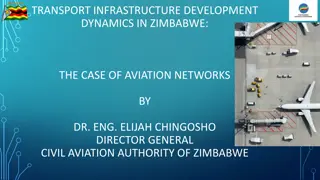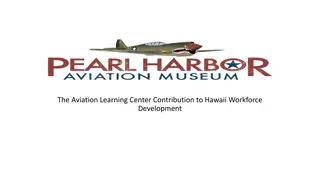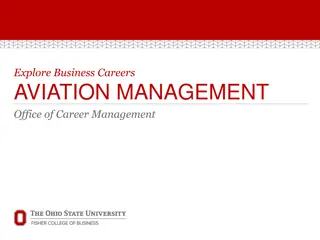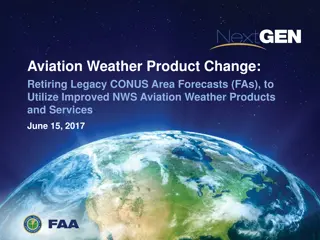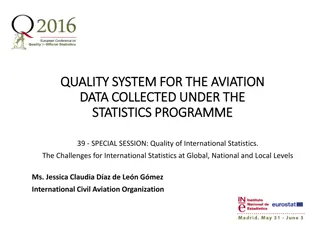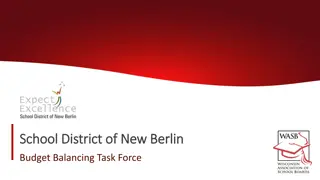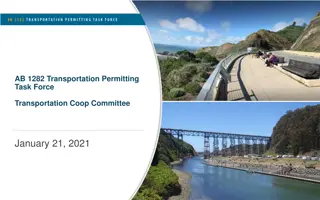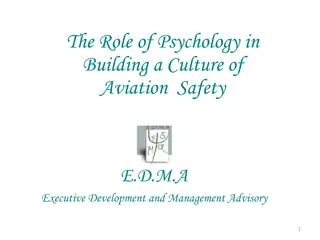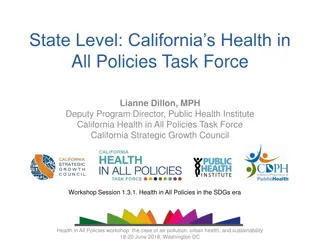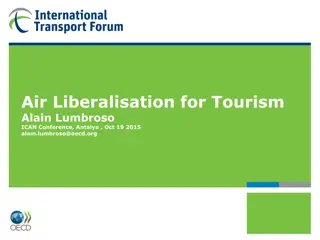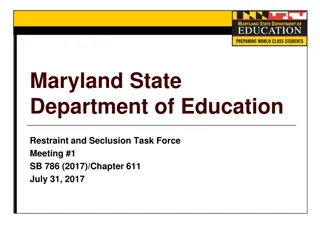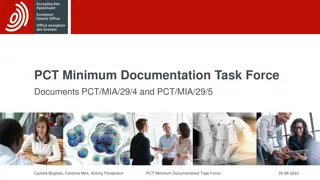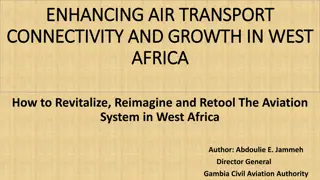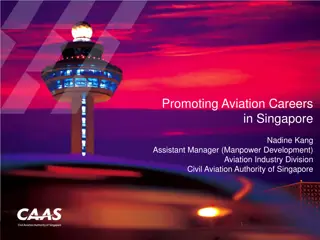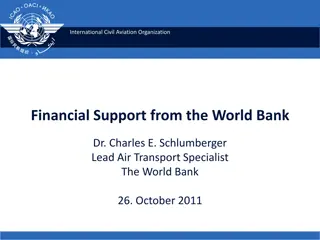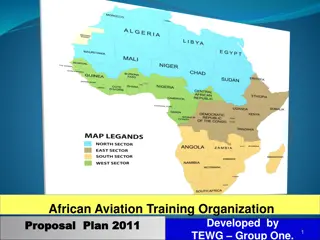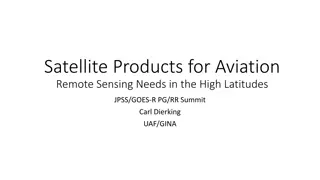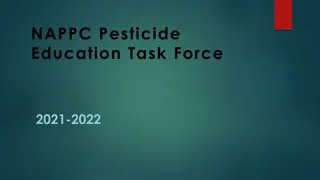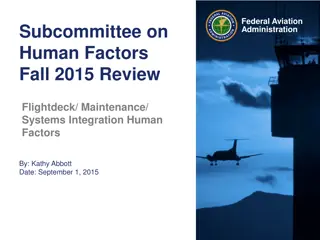Next Generation of Aviation Professionals (NGAP) Task Force Meeting Overview
The Next Generation of Aviation Professionals (NGAP) Task Force meeting was held on December 1, 2015, in Montreal, Canada. The NGAP aims to develop strategies for attracting, training, and retaining aviation professionals to ensure a safe and sustainable global air transportation system. The Task Force structure includes regulators, ANSPs, manufacturers, airports, airlines, and educational institutions. Led by dedicated chairs and supported by voluntary contributors, NGAP works towards achieving its vision and mission through collaborative efforts within the aviation community.
Download Presentation

Please find below an Image/Link to download the presentation.
The content on the website is provided AS IS for your information and personal use only. It may not be sold, licensed, or shared on other websites without obtaining consent from the author. Download presentation by click this link. If you encounter any issues during the download, it is possible that the publisher has removed the file from their server.
E N D
Presentation Transcript
Next Generation of Aviation Professionals (NGAP) 7th Task Force Meeting Stephen P. Creamer Director, Air Navigation Bureau Montreal, Canada 1 December 2015
NGAP: Vision and Mission NGAP Vision A global aviation community that has sufficient competent human resources to support a safe, secure and sustainable air transportation system. NGAP Mission To develop strategies, best practices, tools, standards and guidelines as applicable and to facilitate information sharing activities that assist the global aviation community in attracting, training, educating, and retaining the next generation of aviation professionals. 2
Current NGAP Task Force Structure The Task Force consists of various stakeholders such as: regulators, ANSPs, manufacturers, airports, airlines, international organizations and educational institutions. The work of NGAP is supported by voluntary contributors and the ICAO Secretariat. The Task Force is led by the Chair and coordinated by ICAO. 3
Current NGAP Organization NGAP Task Force Chair: Thomas Carney Vice-Chair: Ashley Lauryssen ICAO: Michiel Vreedenburgh Implementation Working Group Research Working Group Outreach Working Group Chair: William Agius Chair: Lori Brown Chair: Mary Nelson ICAO: Nicole Barrette ICAO: Dawn Flanagan ICAO: Saulo Da Silva
2nd NGAP Global Symposium 3-4 December 2014 No person should be left behind. Aviation is open to everyone. -Julie Payette Director, Centre des Sciences de Montreal (former Astronaut CSA) 8
Phase 2 (2015 -2019) Competencies, Research and Regional Outreach Informal Briefing to the Council 5 October 2015 APAC DGCA Conference theme 26 - 30 October 2015 Council Strategic Planning Group Report 10 November 2015 7th NGAP Task Force Meeting 1 2 December 2015 Internship Toolkit 2015 Amendment to PANS-TRG applicable on 10 November 2016 Publication of ATCO and ATSEP Training Manuals 2016 Regional Implementation Workshops 2016/2017 Identify competencies required for the implementation of SARPs and training programmes 2016 Workshops/Symposia to assist States to implement human resources development and planning strategies - 2016 NGAP Index/Dashboard to provide regional and State forecasts Assembly 2016 Update of global forecasts Doc 9956 2017 9
Challenges Presently, not in ICAO Business Plan or budget (no dedicated full-time ICAO staff) All States are affected by the needs of the global aviation work force (i.e. shortages, migration, etc.) NGAP programme relies mostly on voluntary contributions from organizations and individuals ICAO requires resources for NGAP leadership and coordination efforts 10
NGAP: Task Force transition to a Programme Continue to be supported by partner international organizations led and coordinated by ICAO; Continue to be supported by contributing experts as members of the existing working groups; Continue to work on current activities based on the established priorities, objectives and work plans; Continue to hold annual meetings at ICAO for partner organizations, WGs and contributing experts, and periodic teleconferences in between meetings; Convert Terms of Reference into an Operational Work Plan retaining same vision and mission, adding the objectives, and incorporating the WG work plans; Extend outreach through the ICAO Regional Offices; Expand NGAP to all ICAO Strategic Objectives and aviation professions (Inspectors and Airports); Clarify NGAP links to all ICAO and other Organization related initiatives (e.g. TRAINAIR and IPTC); and Include NGAP in ICAO s Resource Mobilization to raise financial contributions through ICAO voluntary funds (e.g. SAFE-CAPSCA) and continued secondment of experts as contributions in-kind. 11
Task Force to Programme Organisation & Composition Current Task Force New Programme Changes Led by Chairs with the support of ICAO coordination Led and coordinated by ICAO with the support of Partner Organizations Greater ICAO leadership, ownership and support to be achieved by incorporating NGAP in ICAO framework and mandate Management Group (TF & WG Chairs and ICAO) Partner Organizations, WG Chairs and ICAO Partners Organizations are State Regulators, Int l Orgs recognized by ICAO, and Aviation Education Institutions participating in and contributing to NGAP WG Chairs WG Chairs No change WG Members WG Members No change (retain existing criteria and procedure for membership of experts - to distinguish from other meeting participants) ICAO Secretariat ICAO Secretariat No change 12
Role for Regional Offices Support HQ led and coordinated global programme Coordinate between HQ and States on NGAP matters Regional promotion of and dissemination of information on NGAP Support States with NGAP national and regional events Support Outreach WG with State membership Support Research WG with State data Support Implementation WG with organising regional implementation workshops 13
NGAP: Council Guidance Strengthen NGAP initiative by: Formalizing NGAP as an ICAO programme and including objectives in revised GASP and GANP and other ICAO Strategic Objectives (SOs) global plans; Establishing NGAP as a priority in the ICAO work programme and include in the ICAO Business Plan and budget for HQ and ROs; Developing NGAP Strategy for all SOs, other aviation professions and include in the revised global forecasts Doc. 9956; and Reporting to 39th Assembly NGAP Programme progress and a consolidated Resolution encouraging States to participate and support. 14
BACKUP SLIDES 23 September 2024 16
NGAP: Background Since 2008, several reports have forecasted a shortage of aviation professionals. Airbus, Boeing and IATA, among others, concur with predictions of this impending shortage, especially in the areas of pilots, air traffic controllers, aircraft maintenance engineers, as reported in ICAO Doc 9956 in 2011. In May 2009, ICAO created the NGAP Task Force. This resulted from a round-table discussion with industry, regulators, educators, and international organizations. NGAP Task Force is a forum to discuss issues and establish collaboration to support activities to prepare for and engage the next generation. 17
Phase 1 (2009-2014) Raising Global Awareness- Outcomes and Deliverables Two NGAP Global Symposia (March 2010 and December 2014); eight TRAINAIR/NGAP Regional Symposia (2011 and 2013) Development of competency frameworks, provisions and training manuals for ATCOs and ATSEPs 20-year forecast to assist States in quantifying human resources requirements (Doc 9956) 2011 Developed closer links with several key organizations and the aviation training community; e.g. IPTC, ZHAW, Eurocontrol Aviation Tertiary Education Directory (ATED) 2014 NGAP website http://www.icao.int/safety/ngap/Pages/default.aspx 18
Regional Office NGAP Focal Points Regional Office Focal Point Asia and Pacific (APAC) Punya Shakya East and South Africa (ESAF) Milton Tumusiime Europe and North Atlantic (EUR/NAT) George Firican Middle East (MID) Mashhor Alblowi North America, Central America and Caribbean (NACC) Eduardo Chacin South America (SAM) Onofrio Smarrelli West and Central Africa (WACAF) Ousman Manjang 19
APAC/DGCA/52 - Action item 52/1 New Generation Aviation Professionals initiatives Noting the need for quality training institutions in APAC, the Conference encouraged: 1. States in the region to identify their future manpower requirements for aviation professionals and promote investments in modern training institutions/facilities; States to promote collaboration, cooperation and coordination amongst States to nurture and promote the next generation of aviation professionals; and States to give equal attention to the academic input and creating/sustaining a culture of quality within their training organizations. 2. 3. 20
APAC/DGCA/52 - Action item 52/2 New Generation Aviation Professionals Programme Recognizing that enough qualified and competent aviation professionals will be needed to operate, manage and maintain the future international air transport system the Conference urged States to: 1. 2. 3. support the work of the ICAO NGAP Programme by providing resources; consider providing data to ICAO to populate the NGAP index; and provide a focal point from each organization supporting NGAP activities. 21
APAC/DGCA/52 - Action item 52/3 Competency Based ATSEP Model Noting the criticality of ATM systems and operations, the Conference encouraged States/Administrations to: 1. adopt ICAO s new recommendation in the PANS- Training on competency of Air Traffic Safety Electronic Personnel (ATSEP); encourage ANSPs to implement competency based ATSEP scheme to better support the safety critical ATM/CNS equipment operations; support technical staff of NGAP to pursue professional qualification as well as career development in the aviation discipline. 2. 3. 22
Strategic Planning Group Report Recommendation E Secretariat workshops and symposia addressing the implementation of the ICAO Training Policy and assistance to Member States in implementing their human resources development and planning strategies. Main Activities The should organize Organize global and regional symposia addressing training and human resources development in aviation. Develop long-term strategies for Member States to attract young talent to aviation to meet national and global aviation workforce needs, including collaboration with academia to develop specific aviation programmes required to meet identified forecast needs in the aviation industry and strengthen career development programmes for young and emerging professionals, etc. In cooperation with IATA, ACI, and other organizations and manufacturers, launch a global promotion of aviation activities and opportunities in high schools and universities, including a common website on career opportunities in the field of aviation to attract young talent. Link professional training with academic and development of a career plan for aviation professionals and build bridges to attract professionals from other external sources. 23
Strategic Planning Group Report Recommendation C Main Activities The Secretariat should provide training institutions and Member States a list of required competencies implementation of relevant SARPS and training programmes. Identify competencies required for the implementation of SARPs and ICAO Programmes as part of the impact assessment conducted during the SARPs development process. Cooperate with Member States and training institutions to ensure the validity of identified competencies, operational conditions for the implementation of ICAO provisions and expected human and systems performance. Analyse the economic impact and implementation challenges of new SARPs for civil aviation authorities and the industry for the Develop competency-based training guidance material for aviation professionals and civil aviation authorities technical personnel. Provide training institutions and Member States the list of required competencies and generic task list for the implementation of relevant SARPs and ICAO Programmes. 24



